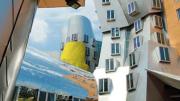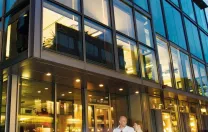How do Harvard’s experiences with architecture and community process compare with those at MIT? Certainly MIT has erected some eye-catching buildings during the past few years: Frank Gehry’s exuberant Stata Center and Steven Holl’s jittery gridded Simmons Hall dormitory. Robert Simha, who for 40 years was MIT’s head of planning, points to the very different physical situations of the two schools. “One major advantage MIT had, in the past, is that it was surrounded by industrial land uses.” As a result, he says, MIT’s relations with its neighbors were “cordial but remote.”
In addition, Simha says, both MIT’s central administration and its plannng officers were encouraged to become involved in Cambridge city affairs, as university representatives and as individuals. Simha once counted that he was a member of 15 different local boards and groups. “We had better eyes and ears on the street,” he says. “The institute had a human face, not just an institutional one.”
He suggests that Harvard’s decentralized organization creates difficulties when it comes to community relations. Because each Harvard school is financially self-sustaining, the University can be reluctant to reveal plans for a specific site until the money is in hand and the project is viewed as “real.” But in the meantime, he adds, information about a project usually leaks out, increasing the distrust of community groups who may be affected.
Yet the differences between the two institutions may be narrowing. Simha points out that as MIT’s residential neighbors have become more sophisticated, and as the Cambridge Historical Commission has taken more interest in the old industrial buildings around the MIT campus, MIT now faces the same kinds of constraints on university expansion that Harvard does.







